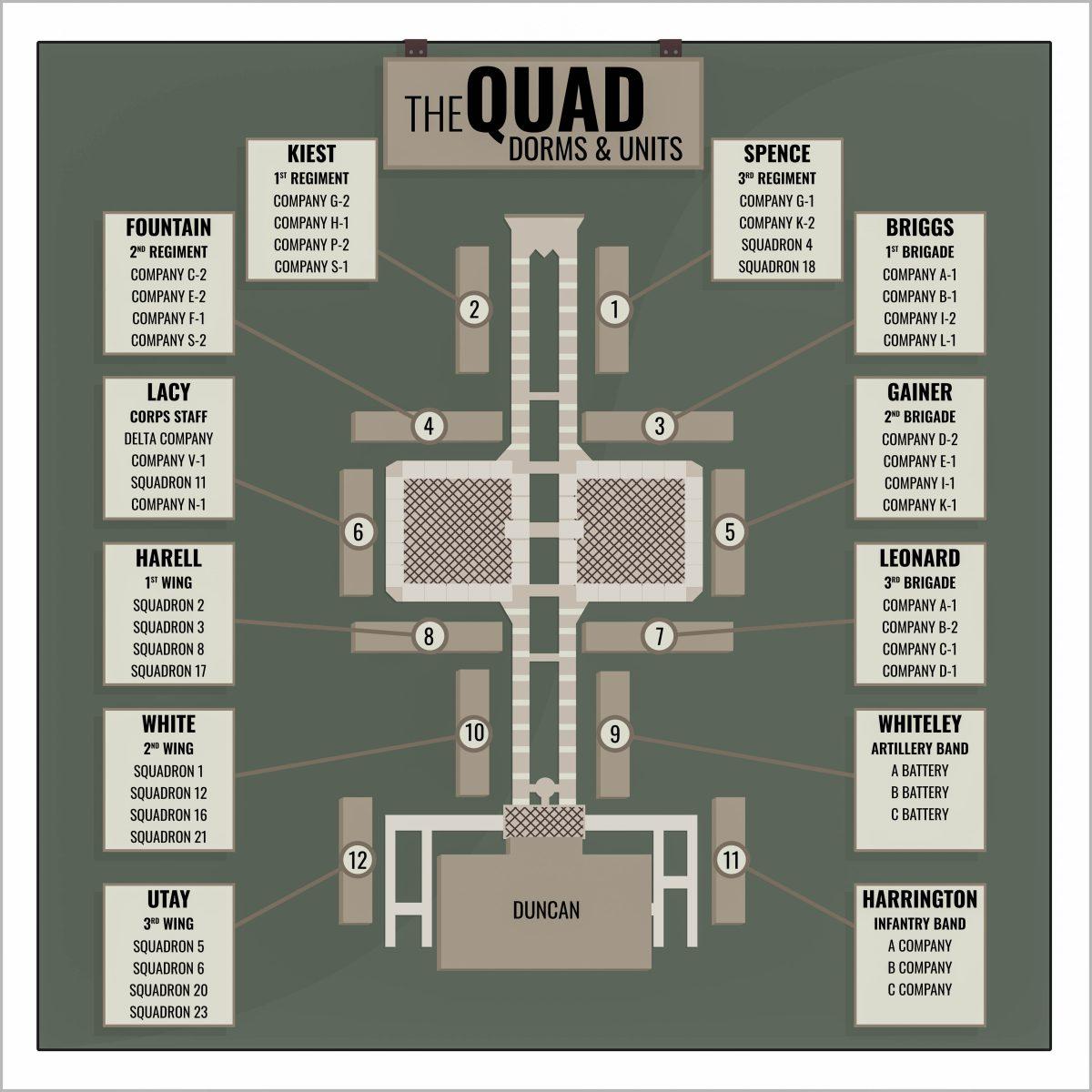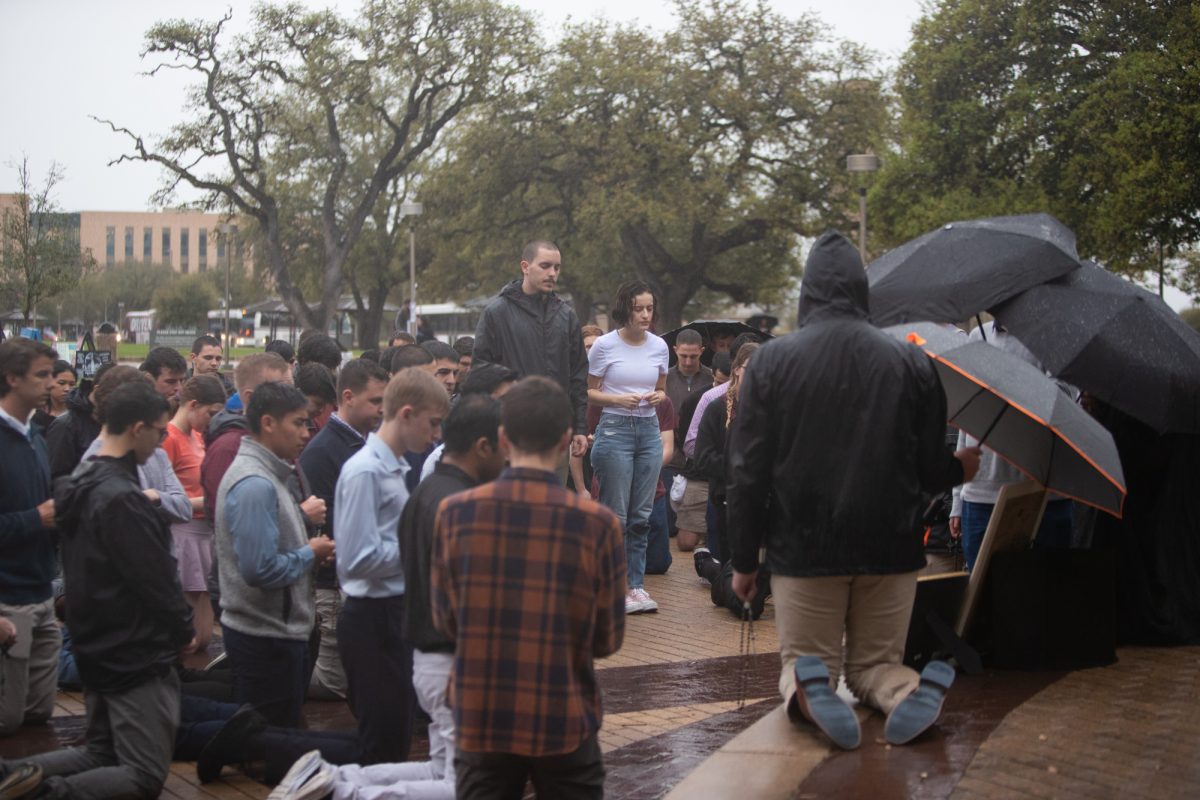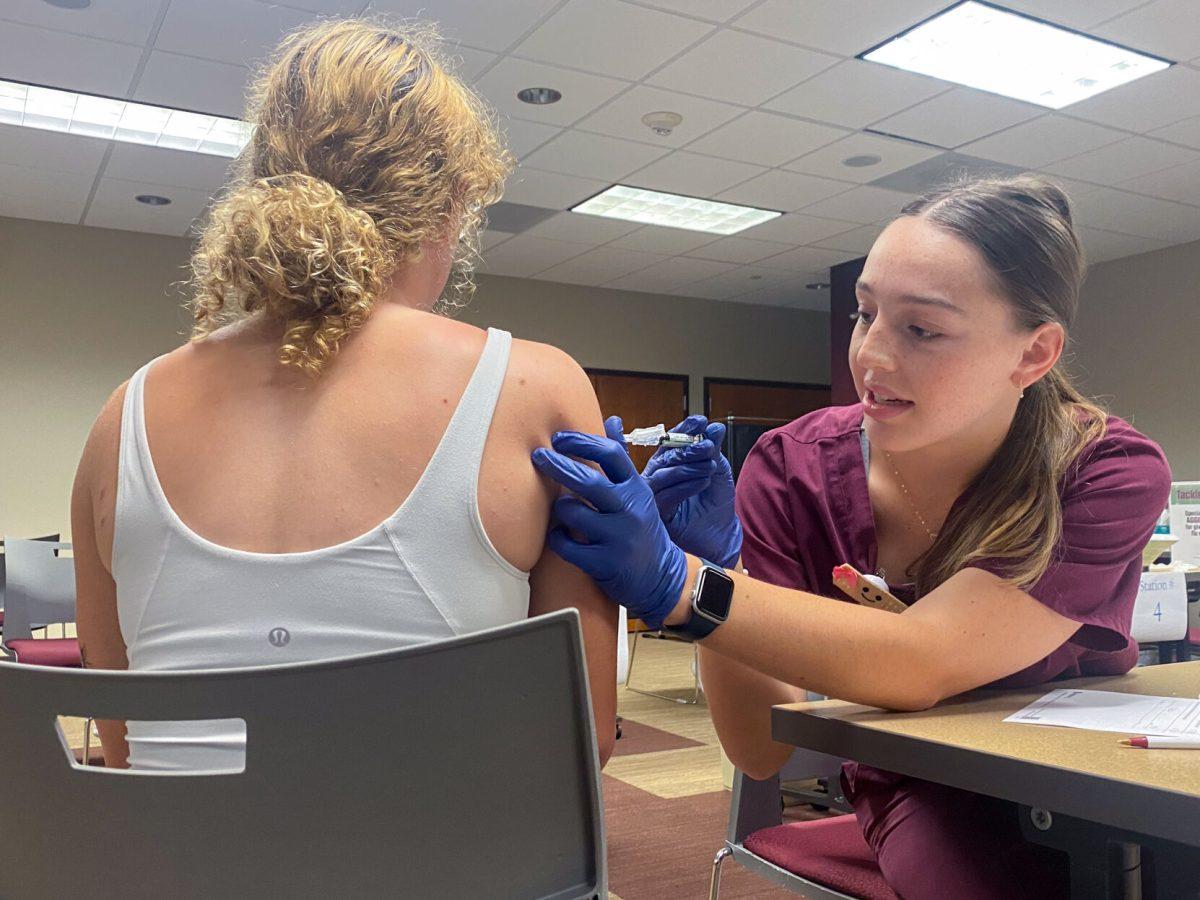Almost all of the roughly 2,500 students in the Corps of Cadets are required to live on campus in the Corps dorms for the entire time they are in the organization. There are 12 dorms located in the Corps Quadrangle, otherwise known as the Quad. In addition to living space, the Quad provides dining services and study spaces. However, the members of the Corps have lived in a variety of other buildings since Texas A&M was first established in 1876.
History
Main Building, or Old Main, was built in 1875 and contained classrooms, offices, a library, an armory and dormitories until the structure burned down in 1912 and was replaced with the Academic Building. Gathright Hall was the mess hall from 1876 to 1933 and also had rooms for cadets.
The first building completely dedicated to housing students was Pfeuffer Hall, built in 1887. Pfeuffer Hall housed 75 cadets and was located in front of where the West Biological Sciences Building would be now. Other dormitories built in the 19th century include Austin Hall (1888-1955), Ross Hall (1892-1955) and Foster Hall (1899-1951).
From 1906 to 1918, there were several hundred canvas tents that housed cadets close to where the Interdisciplinary Life Sciences Building stands today, as the construction of dorms could not keep up with the rapid campus growth rate. The tents were replaced with frame buildings called ‘Hollywood shacks’ until 1931. Goodwin Hall (1908-1989), Mitchell Hall (1912-1972), Puryear Hall (1928-1997) and Law Hall (1928-1997) were built to help fix the housing problem.
Walton Hall and Hart Hall were built in 1931 before the 12 dorms and dining hall that currently make up the Corps Quad were built in 1939. Crocker Hall, Davis-Gary Hall and Moses Hall were built in the same style as the Corps Quad dorms in 1942.
Since 1939, the Quad has been renovated several times — throughout the late 1960s, early 1980s and early 1990s. The biggest renovation to the Quad occurred from 2015 to 2017 and added four study spaces called Leadership Learning Centers (LLCs), a Starbucks and improved landscaping and lighting. The interiors of all 12 dorms were completely renovated. According to Housing Assignments Office Associate Director Jeff Wilson, the cost to renovate each dorm was around $9 million.
Regulations
The dorms can house a total of 2,600 cadets. The cadets are housed two per room and there are two community restrooms per floor. The Corps dorms are named after people who have made contributions to the university, but they are typically referred to by their assigned numbers, one through 12.
Assistant Commandant of Operations and Training Col. Glenn Starnes is in charge of working with Resident Life in cadet room assignments, summer housing and future housing plans.
Usually, each brigade, regiment and wing receives their own dorm, and each unit or outfit has their own floor. However, because not all units are integrated and the size of the Corps fluctuates every year, there are sometimes vacant rooms that can be used by non-Corps members. However, the entire floor has to be empty for non-Corps students to live there.
According to Starnes, this year is the first time in a while that there were enough vacancies on the Quad for non-Corps members to move in. This year, there are two floors of one dorm reserved for non-Corps students. Each floor gets a resident advisor as if they lived in the other resident halls.
All students participating in the Corps are required to live on campus unless they qualify for day student status. Starnes said cadets can qualify for day student status if they are married, have previous experience in the military, live with their family in the Bryan-College Station area or are varsity athletes.
Combat Veterans are placed in Delta Company, or D Company, because they will most likely not need to stay for a full four years. These cadets have the option to live on or off campus.
Non-traditional students like married cadets, veterans, cadets who want to save money by living with their parents in Bryan-College Station and varsity athletes are placed in V-1. Outside of living off campus, these cadets still participate in other mandatory Corps activities.
Cadets are required to attend five morning formations and three evening formations per week. Following these formations, they eat at Duncan Dining Hall. Starnes said cadets have meal plans to pay for these eight “march-in meals” per week.
The Corps dorms have their own separate handbook with the Department of Residence Life. A lot of the handbook matches the regulations given to other on-campus residents. However, instead of resident advisors, the Corps has Housing Officers that enforce dorm policies. Even if cadets are 21 or older, they are still not allowed to have alcohol in the dorms. Additionally, no more than four cadets are permitted in one room at a time.
Routine room or “hole” inspections are performed for all Corps dorms. Inspectors look at the cleanliness of floors, mirrors and storage areas. Each shirt, jacket, pair of trousers and piece of headgear must be organized in a particular order and in a certain way in the closet, and beds must be made in a certain way every morning. Additionally, the furniture cannot be rearranged.
Room decorations are restricted based on a cadet’s classification. According to Starnes, freshmen are not allowed to put up posters, curtains, use rugs, fitted sheets, or mattress pads. They are also limited to three items or less on their desks. As their classification increases, cadets can decorate their hole more. Sophomores are allowed one poster or flag, a small bath mat, a small rug, a coffee maker and no more than five items on their desk. Juniors and seniors are allowed curtains, more wall decorations, one microwave and refrigerator, a video game system and a television smaller than 40 inches.
“It’s just an austere life for them,” Starnes said. “You have to be willing to live that Corps lifestyle.”
Features
As part of the 2017 renovations, four LLCs were added to the Quad. The first floors contain offices for Corps Staff, while the other three floors have meeting rooms, group and individual study rooms and computer labs. The academic resources available in the LLCs are available to all students, not just cadets.
Starnes participated in the Corps from 1977 to 1981 before serving in the United States Marine Corps. Starnes was in C-2, moved dorms every year and said that living with the Corps has changed since his time at A&M.
“The dorms are much nicer, a little bigger and the furniture is better,” Starnes said. “Everything’s much more climate-controlled. The dining hall has more opportunities for you to eat different things. When I was here, we ate family-style.”
Starnes said living with the Corps dorms is like living in a Living Learning Community because they have upperclassmen that act as mentors. According to Starnes, living on campus also makes university traditions more accessible.
“We have 44 individual living learning communities here on the Quad, each of them helping sophomores and freshmen with their academics,” Starnes said. “You’re part of the traditions that you’re also building.”
A look at on-campus life in the Corps of Cadets throughout its history and today
March 6, 2019
Photo by Graphic by Nic Tan
The Quad, short for Quadrangle, includes 12 dorms and Duncan Dining Center — a dining location for both Corps and non-reg students.
0
Donate to The Battalion
$2065
$5000
Contributed
Our Goal
Your donation will support the student journalists of Texas A&M University - College Station. Your contribution will allow us to purchase equipment and cover our annual website hosting costs, in addition to paying freelance staffers for their work, travel costs for coverage and more!
More to Discover










